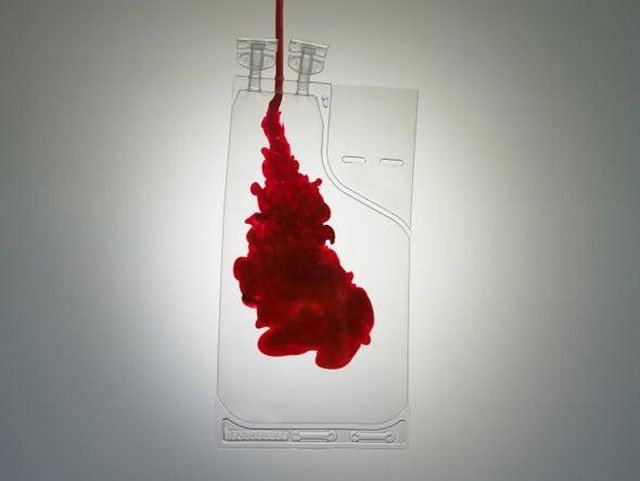Her blood becomes a powder-like powder, which helps preserve and last longer
Like milk, blood has a shelf life. When a blood donor gives away their precious fluid, doctors collect the blood in bags and store them in the refrigerator. If not kept cold, fresh blood has a shelf life of only 30 minutes, because bacteria can grow inside it.
In fact, contaminated blood is the leading cause of death in blood transfusion accidents. To prevent this from happening, the blood must be stored at a standard temperature of 2-6 degrees Celsius, and must be transfused within 4 hours after removing from the refrigerator.
But even after being refrigerated, the blood has a maximum shelf life of only about 35 days after donation . Simply because in that time the blood cells have completed their life cycle, the blood will die.
This makes blood donation necessary to perform regularly, when the blood bank reserves are too low. Difficult will also occur in remote areas where there is not enough cold to store blood. So researchers are trying to find a way to preserve blood for longer without a refrigerator.

Contaminated blood is the leading cause of death in blood transfusion accidents.
One of the interesting ideas was to make powdered blood . It's easy to imagine, if we can turn raw milk into powdered milk, for longer preservation, then just mix with water to drink: Why can't it be done with blood?
Jonathan Kopachek, a biological researcher at Louisville University, USA is pursuing the idea of concentrating blood to turn it into a powder at room temperature. He said this method could preserve blood for longer periods, allowing us to cope with blood scarcity in many parts of the world, something that has happened even in major hospitals in the Covid-19 pandemic.
Removing water from blood without damaging the cells is a very complex and challenging process. But Kopachek said a special molecule that could help in this process is a sugar called trehalose . Interestingly, it is also a common preservative in donuts.
"Trahalose can keep the cakes looking fresh even if they were made a few months ago ," Kopachek said. " And you won't see the difference".
The researchers chose trehalose because in nature, this sugar molecule is also made by tardigrades or salt-water bears - or sea monkeys. Trehalose makes it possible for these tiny organisms to survive extremely harsh living conditions, where salt concentrations are so high that salt can drain water from their bodies.
Observations show that water bears and salted shrimp can live in a completely dry state for a long time, until they are rehydrated and functioning normally again. " So we want to use trehalose made by these organisms, and apply it to preserve dry blood cells, just like those organisms did ," Kopachek said.
To begin with, researchers must find a way to get trehalose into the blood cells. They used ultrasound to drill holes in the cell membrane. The holes allow some trehalose molecules to enter, which will then close automatically.
The key is that the amount of trehalose both inside and outside the cell needs to reach a level sufficient to help the cell survive the process of dehydration and rehydration. At that concentration, the blood can be dried to form a powder.
Kopachek says that in the form of a powder, the blood can be stored for up to several years at room temperature, meaning that you don't even need to use the refrigerator. When it is needed to give the patient an infusion, "we just need to mix the water and the blood will return to normal ," he said.
Another interesting thing is that because the blood has many different components, with different storage conditions, such as platelets, red blood cells, Albumin, Cryoprecipit, we can also concentrate them into powder. different to use or mix.
Currently, fresh serum and Cryoprecipit can be stored at -30 o C and only have a shelf life of 4 hours after defrosting. Platelets are not cooled and can only be transferred within 5 days after donation.
Albumin is only stored at room temperature, but in the dark. Its shelf life is 3 hours, but will quickly fail when exposed to light.
Preliminary research on the idea of sending trehalose into red blood cells to concentrate and preserve blood powder of Kopachek has been published in the journal Biomicrofluidics. However, he stressed that it will take 3-5 years before this powdered blood is ready for clinical trials.
Even so, later application opportunities are very promising. Powdered blood can help us store blood longer, limit blood donations and blood shortages in hospitals. Powdered blood can also serve patients in remote areas, or during pandemic scenarios.
In addition, Kopachek said with its preeminent properties, powdered blood could be the preferred choice for humanitarian aid, military operations or even Mars missions. Perhaps, the first aid kit that astronauts bring to Mars will contain a bag of powdered blood.
- The powder helps American farmers preserve their long-lasting fruit and vegetables
- The powder helps the soldier have a hot meal for 10 minutes
- The truth about drinks helps people live without eating
- Artificial blood can save patients' lives like real blood
- Unusual uses of blood
- Treatment of high blood pressure increases life expectancy
- Stun with super fast flour
- Donating blood helps avoid serious diseases
- How to distinguish real chili powder and fake chili powder
- The elixir helps you reduce blood fat
- From powdered vegetables, female students create 'nylon' bags that can dissolve in water
- Technology helps wash clothes without washing powder or any bleach
 13 causes of non-itchy rash
13 causes of non-itchy rash How the mouse with human ears changed the world?
How the mouse with human ears changed the world? The truth about 'fried rice syndrome!
The truth about 'fried rice syndrome! What is dental implant?
What is dental implant?